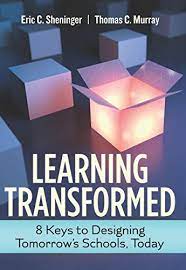8 Keys to Designing Tomorrow’s Schools Now
Learning Transformed: 8 Keys to Designing Tomorrow’s Schools Today
By Eric C. Sheninger and Thomas C. Murray
(ASCD, 2017 – Learn more)
Reviewed by Theresa Wood
Students at our online school are there for a variety of reasons. Some are battling anxiety disorders or ADHD and thrive in an environment where sensory stimuli are manageable.
Others realized during the pandemic-related lockdown that the traditional model of school no longer works for them – seven hours being warehoused in a brick-and-mortar building for about four hours of basic content, limited options for choosing arts-related (or technology-related) courses, inconsistent expectations for demonstrating mastery, not mention crowded classes with too many behavior problems and regular crises and active shooter drills.

All of these changes led to many discussions about the purpose of school. Are we educating students to be successful in their future jobs? To be better citizens? To be better humans in control of their emotions and able to work well with others?
Or are we just glorified child care, open solely for the convenience of working parents?
“You are part of the solution.”
Granted, these issues were problems before the pandemic and questions like these have been debated since the founding of public schools. This 2017 book from Eric Sheninger and Thomas Murray demonstrates the “timelessness” of some of these education dilemmas.
The authors of Learning Transformed: 8 Keys to Designing Tomorrow’s Schools Today open with an overview of the problems facing the American public school system including low NAEP and SAT scores, lack of student engagement as seen in the rise in chronic absenteeism, achievement gaps, and the digital divide.
Defining the issues creates a sense of urgency and challenges all of us to stop talking about the problems and do something about them.
In the Introduction, the sentence “You are part of the solution” is repeated five times, once at the end of each section, as a mantra. When I first read this, I replied, “Yeah, but…” each time. I am just a classroom teacher, I said to myself. I am powerless to affect change. Sheninger and Murray were prepared for me, though.
The 1st key: Leaders by action
As they define the steps necessary to implement Key #1, “Creating a Culture of Innovation,” they distinguish between leaders by title (LBT) and leaders by action (LBA). In this passage they issue a call to action for anyone concerned about the stagnant state of American education today:
“They are teachers, students, parents, support staff members, and administrators who have taken action to initiate meaningful change in their classrooms or schools.…They lead by example in what might be the most effective way possible: by modeling.…It doesn’t take a title or a new position for these leaders to be agents of change” (35).
Reading this caused me to pause and reflect on all the ways that I have initiated change through my own practice and recognize that, perhaps, my efforts have not been in vain. It also led me to realize how often, though, I have done the opposite.
I have often waited for a building leader to inspire me with their visions, and in the absence of such a person, I have allowed myself to languish. The next time I encountered the mantra “You are part of the solution” at the end of this chapter on leadership, I believed I was – and I am.
Each key offers realistic ideas
The keys that follow are as well-developed as the first with a variety of realistic ideas and examples for schools and educators to adopt. They focus on redesigning pedagogy with a new mantra – intentional design:
- measuring success accurately by looking beyond test scores;
- redesigning the physical spaces in the school building;
- changing the way teachers further their professional development;
- using technology effectively;
- working with the community outside of the school building;
- developing systems to guarantee long-term success.
- leading the charge.
Each chapter ends with a spotlight on a school or school district that has successfully implemented the element of change outlined in the previous pages.
The appendices include valuable resources such as a description of and links to the organization Future Ready Schools ® which advocates using a data dashboard to take school leaders through the process of creating meaningful change. There are also tips for using social media to celebrate your school’s efforts and successes and a list of the schools highlighted throughout the book.
A necessary and still timely blueprint
Even though it was published over five years ago, this book is more relevant today than ever. It offers a blueprint of practical ideas to reinvent schools so that all students receive an appropriate and useful education, all teachers are respected and treated as professionals, all families and community members are welcome and value the role schools play in developing the next generation of citizens, neighbors, and workers.
It sounds like a pipe dream, but as the schools which have gone through the process can tell you, it can be done with a clear vision and buy-in from all stakeholders.
To build on Anatole France’s quote, “If you’re not changing, you’re not growing. If you’re not growing, you’re not living,” I would add, “And if you’re not living, then you’re dying.” America’s public schools are in danger of dying and the sense of urgency is not hyperbolic.
Theresa Wood, M.Ed. is starting her twenty-fifth year teaching in elementary and middle school classrooms. She currently teaches middle school English/Language Arts, where she has worked for seventeen years, and enjoys sharing her enthusiasm for literature and language. She is an unapologetic bibliophile, has served as department chair, team leader, a mentor for new teachers, and is a graduate of the National Writing Project.




































I think these are some of the most important questions to ask of our lives. I’m a teacher, and a father. Education has to reinvent itself. The default public perspective is: “the school and teachers are to blame.” And teachers are given almost impossible tasks, upon tasks, and the public is not privy to the incredible work being done because the narrative is being controlled by people who have no experience in the classroom. Covid taught us that leadership has to change. Too many admin sit on their hands, as legal issues often bind their scope!